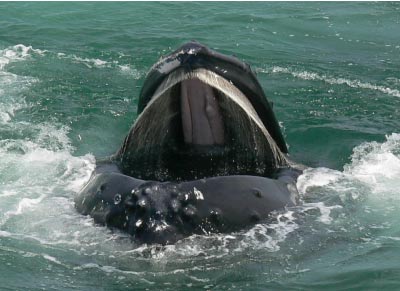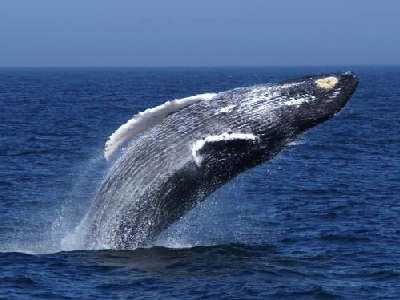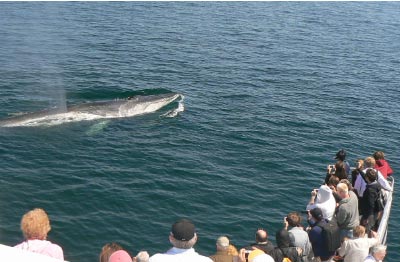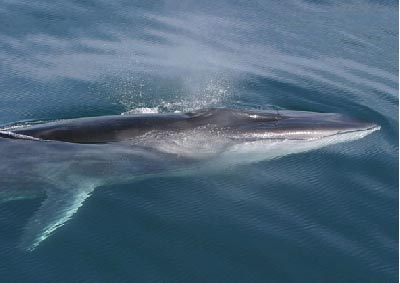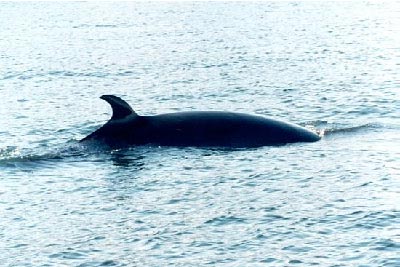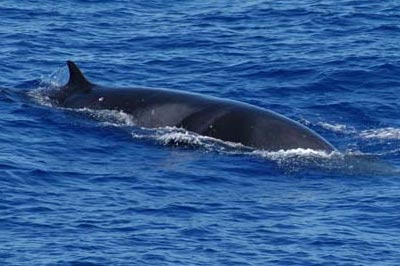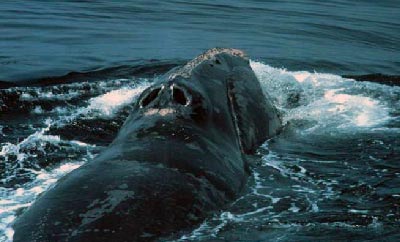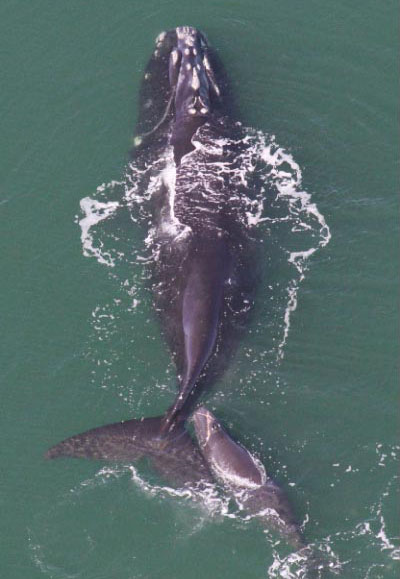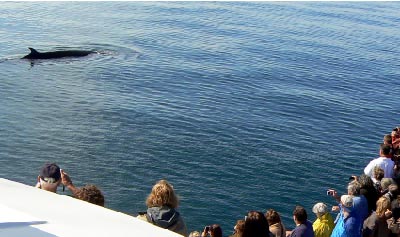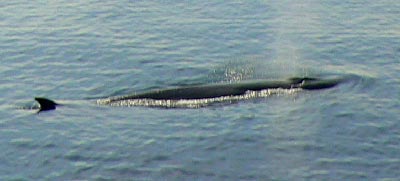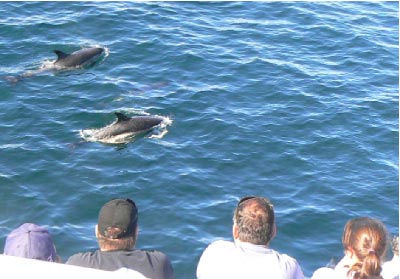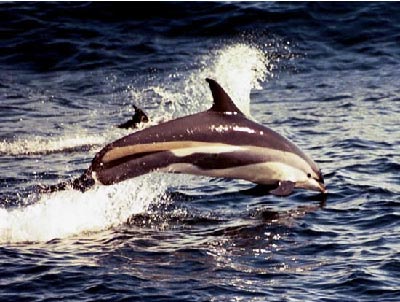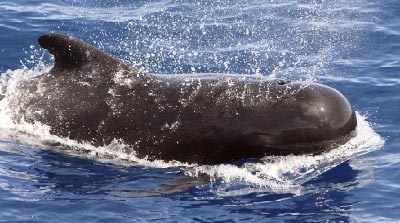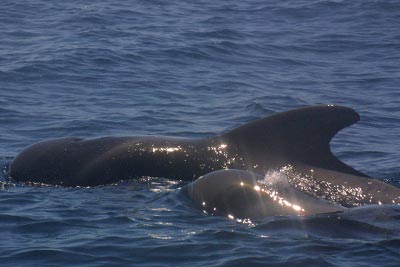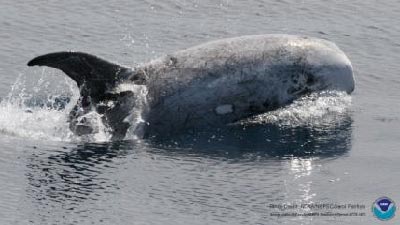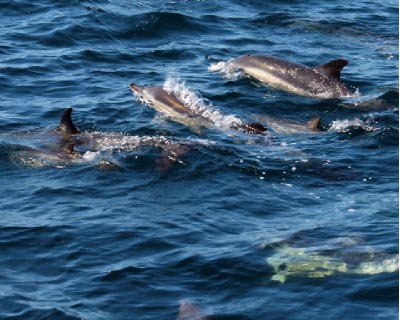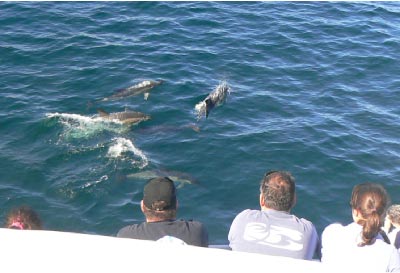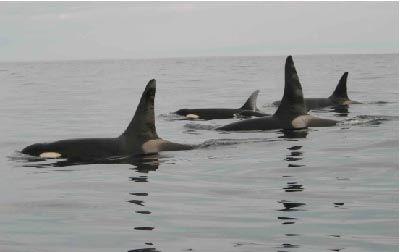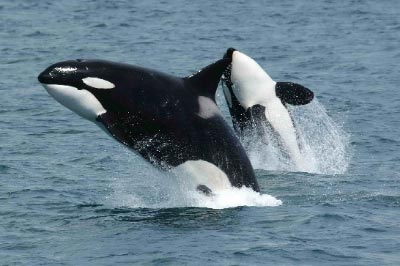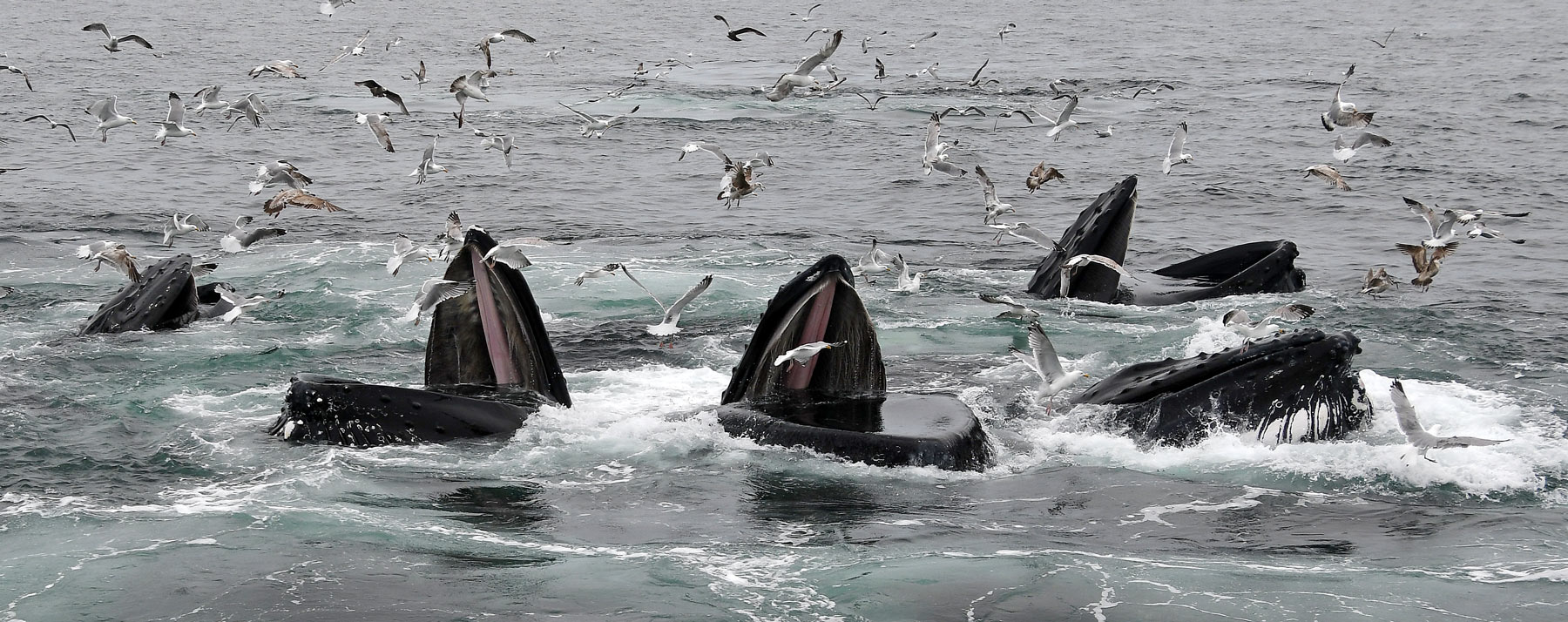
Whales belong to the scientific order Cetacea, which is divided into two groups: the Mysticetes (Baleen) and the Odontocetes (Toothed Whales). The Mysticetes, or baleen whales, are the majority of the whales that we find in our area. These whales don’t have any teeth! Instead they have baleen plates made up of keratin, the same material that makes up our hair and fingernails. These plates hang down from their upper jaw and allow the whales to filter their prey (usually planktonic animals and small fish) from the seawater. This group consists of the blue whale, fin whale, right whale, humpback, minke, and others. The Odontocetes, or toothed whales, use teeth to seize and capture their prey. Sperm whales, belugas and narwhals, all of the beaked whales, and all of the dolphins and porpoises all belong to this group.
Humpback
Length: 35-50 ft. (Females larger than males)
Weight: 25-40 tons
Range: All major oceans
Humpback whales are mid-sized baleen whales that frequent our area in the summer months. They get their name “Humpback” from a small hump on their back located just in front of their small dorsal fin. These whales have a black body with white flippers (pectoral fins). These flippers are the longest of any whale, reaching up to 15 feet. This can be a third of the whale’s body length! The underside of the flukes (tail) vary in color from all white to all black with everything in between. These color patterns are unique to each whale, and allow scientists to identify individuals and keep track of them. Humpbacks also have a number of bumps on their heads, called tubercles, each containing one hair. Scientists believe the whales use these hairs as a sensory device. They have anywhere from 270-400 baleen plates on each side of their mouth.
The humpbacks we see in our area spend the winter months in the Caribbean, an area that serves as their breeding and calving grounds. Humpbacks give birth in the middle of winter to calves that weigh around a ton! These are big babies: they’re born anywhere between 13-15ft. long! They can gain as much as 100 pounds a day just by nursing on their mother’s milk! After traveling up from the Caribbean, humpbacks in our area stay in the Gulf of Maine from late spring to early fall feeding. These whales are feeding on krill (tiny shrimp-like animals) and small schooling fish including herring, sand lance, and mackerel.
The favorite of many whale watchers, humpbacks are known for a variety of behaviors, some of which appear to be playful. Rolling, flipper slapping, tail lobbing, spy-hopping, and breaching are some examples of these behaviors.
Fin
(Balaenoptera physalus)
Length: Approx. 80 ft. (Females larger than males)
Weight: 60-85 tons
Range: All major oceans
Fin, or finback, whales are the second largest animals to ever have lived on earth. In fact, the only animal larger than a finback is a blue whale, which can get up to 100 feet long. Finbacks are a very close second though, reaching up to 80 ft. long, and sometimes a little longer. These whales are dark gray on top from the tip of their mouth to their tail, and are white underneath. They have a “V” shaped chevron pattern, lines of light gray, located behind the blowholes. These whales are easily identified because the right side of their face is white while the left is gray, known as asymmetrical pigmentation. In fact, even the baleen in the front of the right side of the mouth is white. Scientists believe this difference in color helps the whale feed. Finbacks have between 260-480 baleen plates on each side of their mouth.
Although they are enormous animals, finbacks have a very sleek and streamlined body that helps them swim very fast. In fact, they are the fastest of the baleen whales, giving them the nickname “greyhound of the sea.” These whales can reach up to 30 miles per hour in short bursts. Finbacks eat krill and small schooling fish including herring, capelin and sand lance.
Minke
(Balaenoptera acutorostrata)
Length: Approx. 30-35 ft. (Females larger than males)
Weight: Approx. 10 tons
Range: All major oceans
Minke whales are the smallest of the baleen whales found in our region. Their body is dark gray on top and white underneath. They have a small, curved dorsal fin and they have small pectoral fins. These flippers are dark gray with a white band. When minke whales surface, they often come up at an angle, which usually means that their spout gets lost in the waves behind it. Minkes, therefore, get the nickname “little piked whale” because they often come up chin-first. Scientists find these whales difficult to study because they are frequently found alone, and they are very quick. Often one will pop up once and then disappear. However, they can be seen in small groups and in association with other larger whales, usually in an area with an abundance of food.
For a long time these whales were considered too small to hunt, but as the numbers of larger whales declined, whalers turned to these small whales. In fact, these whales continue to be hunted today by Japan, Norway, and Iceland.
North Atlantic Right
(Eubalaena glacialis)
Length: 50-60 ft. (Females larger than males)
Weight: Approx. 200,000 lbs.
Range: Nova Scotia to Florida; southern Iceland, and Norway to Spain
The Right whale is a mid-sized baleen whale. They are mostly dark gray to black with small amounts of white on the underside of their body. They have small paddle-shaped flippers, a large head that is covered with callosities (raised, rough patches of skin), a deeply notched tail, and no dorsal fin. Their callosities are covered with whale lice, and each right whale’s callosities form a unique pattern that allows scientists to identify individuals. They are easily recognized because they lack a dorsal fin, but also because their spout forms a very distinct “V” shape. These whales are found off Cape Cod in winter and spring, the Bay of Fundy in summer, and off Florida and Georgia (their calving grounds) in winter. Right whales are different from the humpback, finback, and minke because they are skim feeders and feed exclusively on tiny planktonic animals. Instead of gulping like the other whales, right whales feed at the surface with their mouths partially open, filtering as they swim. Their baleen is much finer than the other three previously mentioned whales, and is also much longer. Minke whales have baleen that is about 8 inches long, humpbacks about 12 inches long, while right whales can have baleen that is 9 feet long.
Unfortunately, right whales are one of the most endangered mammals in the world. Their population consists of approximately 400 individuals. In fact, they got their name because they were the “right” whales to hunt. These whales are slow swimmers, which made them easy to catch, they floated once killed, and they produced a large amount of oil and baleen. Their baleen, called whalebone by the whalers, was used for a variety of things including umbrellas, women’s corsets, and buggy whips. Today these animals are federally protected because they still face many threats, though they are no longer hunted. A large number of mortalities come from ship-strikes and entanglements in fishing gear.
Right whales cannot be approached within 500 yards.
Sei
(Balaenoptera borealis)
Length: 50-65 ft.
Weight: 100,000 lbs.
Range: worldwide from tropical to sub polar waters
Sei whales are the third largest baleen whale. These whales are usually dark gray on top and white on the belly. Their dorsal fins are tall and curved. Sei whales look similar to finbacks, although both sides of the face are dark gray (unlike finbacks which have different colors). They have between 300-410 baleen plates on each side of their mouths, and their baleen is very fine. Like the finback, Sei whales have a very sleek body, which allows them to swim very fast. Sei whales are known for their unpredictable distribution, with a sudden arrival into an area followed by an absence for years. Their migration still remains a mystery to scientists. Likewise, very little is known about the social behavior of these whales. They have a broad diet including copepods (small planktonic animals), krill, squid, and small schooling fish. Sei whales are the only baleen whales to feed both by skimming and gulping. Although not a common visitor to our area, they have been seen the past couple of years.
Atlantic White Sided Dolphin
(Lagenorhynchus acutus)
Length: 8-9 ft. (Males larger than females)
Weight: 400-500 lbs. (Males weigh more than females)
Range: North Atlantic temperate waters; from mid-Atlantic states to Northern Europe
Atlantic White Sided Dolphins are the most common dolphin found in our area, and are one of the most attractive of all cetaceans. These dolphins are named for and are easily identified by their markings. They are dark gray to black on their dorsal surface; the sides of the body are light gray from head to tail; they have a white belly and a white patch below the dorsal fin; they also have a well defined yellowish-tan patch on both sides of the body above the white patch that extends towards the tail. They have a short beak (rostrum), small flippers, and a curved dorsal fin. Like most toothed whales, these dolphins are highly social and can be found in groups (pods) anywhere from 8 to hundreds of individuals. They are sometimes even found in association with humpback and finback whales. These dolphins, sometimes referred to as “lags” because of their scientific name, eat a wide variety of prey species including squid, herring, mackerel, hake, and sand lance.
Long-Finned Pilot Whale
(Globicephala melaena) https://www.nmfs.noaa.gov/
Length: 15-20 ft. (Males larger than females)
Weight: 2900-5000 lbs.
Range: North Atlantic and cool water in all oceans in the Southern Hemisphere (circumpolar)
Pilot whales are seasonal residents in our area. Their bodies are dark gray to black with a light patch behind their dorsal fin, and a white patch on their throat that resembles an anchor. They have a short beak, a very round, or bulbous, head (called the melon), and a very thick, curved dorsal fin. People often refer to pilot whales as “potheads” because of their bulbous head. They are usually found offshore throughout most of the year, but come inshore following food and can be seen in our area in late summer and early fall. These whales primarily feed on squid and mackerel, but will also feed on a variety of small fish. They are usually seen in small groups (pods) of 10-20 individuals, but can be found in much larger groups.
Unfortunately, pilot whales are often known for their tendency to have mass strandings, including here on Cape Cod. Scientists continue to study these incidents to try and learn what might cause these animals to strand. Could it be a result of navigational difficulty, prey chasing, disease, or predator avoidance? Most likely it is a combination of these, but the answer is still unknown.
Risso’s Dolphin
(Grampus griseus)
Length: 12-13 ft. (Males are slightly larger than females)
Weight Unavailable
Range: All major oceans, tending to be in tropical and temperate waters
Risso’s Dolphins are not a common visitor to Stellwagen Bank because they are typically found further offshore; however, they can be seen in our area on occasion. These dolphins progressively change color from dark gray to light as they become adults. They somewhat resemble pilot whales because they have a very short beak and a rounded head (though not as bulbous as a pilot whale). Risso’s Dolphins also have a curved dorsal fin (taller than a pilot whale), and small paddle shaped flippers. Often referred to as “grampus” because of their scientific name, they are known for scars and scratches that mark their bodies, most of which come from other Risso’s Dolphins. These dolphins are usually found in groups of 12-25 individuals, sometimes more. Squid makes up the overwhelming majority of their diet. When these dolphins are seen in our area, it is likely a result of them coming inshore following squid.
Short-beaked Common Dolphin
(Delphinus delphis)
Length: 8-9 ft. (Males larger than females)
Weight: Approx. 330 lbs.
Range: tropical and warm temperate waters of the Atlantic and Pacific Oceans
Another species that is not often found over Stellwagen Bank, the Common Dolphin is generally found further offshore. These dolphins have a medium sized beak (larger than Atlantic White Sided Dolphins), a tall, curved dorsal fin, and medium sized flippers. Their bodies are white underneath and dark gray to black across the length of the back, including the tail. They have a tan patch on both sides that runs from the eye to the middle of the dorsal fin; and they have a light gray wash across their backs that meets the tan patch on both sides. This creates an “hourglass” shape on both sides of the body, which makes identifying this species relatively easy. These dolphins are usually found in groups of about 30 individuals or less, but can be found in hundreds and sometimes thousands. Like other toothed whales in our area, Common Dolphins rely on squid and small schooling fish for food.
Killer Whales
(Orcinus orca)
Length: 25-30 ft. (Males larger than females)
Weight: 8,400-12,000 lbs.
Range: All major oceans
Killer whales are one of the most recognized of all the whales, however, they are not often seen over Stellwagen Bank. These animals are often found further offshore, and the last confirmed sighting on Stellwagen Bank was in 1986. Killer whales, often referred to as “Orcas,” are, in fact, the largest member of the dolphin family. They have a very robust body, large rounded flippers, and a small beak. Their bodies are mostly black, with a white belly, white patches behind the eyes, and a light gray to white patch behind the dorsal fin. A male’s dorsal fin is tall and triangular, and can reach up to 6 feet tall. A female’s dorsal fin is much shorter and curved. Killer whales have 10-14 pairs of large teeth, which they use to eat a wide variety of prey. These whales have been known to feed on small schooling fish, squid, seals, and even large baleen whales and sperm whales.

